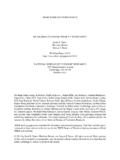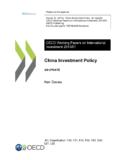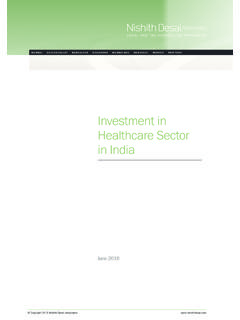Transcription of Defining and Measuring Innovation in all Sectors of the ...
1 Defining and Measuring Innovation in all Sectors of the Economy: policy Relevance Fred Gault UNU-MERIT, Maastricht, The Netherlands and the Tshwane University of Technology (TUT) Institute for Economic Research on Innovation (IERI), Tshwane South Africa Abstract This paper proposes generalized definitions of Innovation applicable in all economic Sectors of the System of National Accounts (SNA) to support international comparison of Innovation in each sector , as well as monitoring and evaluation of Innovation policies that have been implemented. The extension of Innovation measurement to all Sectors has implications for policy learning and for global impact.
2 July 2016 OECD Blue Sky Forum III, Ghent, Belgium, 19-21 September 2016 1 1. Introduction Innovation drives growth and helps address social challenges (OECD 2010a). Innovation mitigates climate change, advances sustainable development, and promotes social cohesion. There are many claims for what Innovation does, but to support these claims, to inform policy development, and to monitor and evaluate policy implementation, Innovation has to be measured. This paper is about Measuring Innovation , how that measurement is broadening, how the resulting indicators are changing and how this has implications for policy . Defining and Measuring Innovation , a historical perspective Before Innovation can be measured, it must be defined for statistical purposes.
3 There has been a formal definition since 1992, but, unlike the definition of research and experimental development (OECD 2015a) which has been around twice as long, the definition of Innovation for statistical purposes has evolved. What has remained constant through all the revisions is the requirement that a product be brought to the market. One of the objectives of this paper is to provide a broader definition in which product is made available to potential users. Oslo Manual first edition The definition of Innovation grew out of experimental Innovation surveys of the 70s and 80s leading to the first codification of how to define Innovation for measurement purposes in the first Oslo Manual (OECD 1992).
4 That manual was limited mainly to manufacturing, although services were mentioned (OECD 1992: para. 239) and it involved only technological product and process Innovation . The process was the production of a product. The first edition of the Oslo Manual was partially implemented through the first European Community Innovation Survey (CIS) conducted for reference year 1992. Oslo Manual second edition After five years the manual was revised (OECD/Eurostat 1997) to include services, which dominated GDP, then as now, but it was still about technological product and process Innovation , and putting of product on the market.
5 Process Innovation included production, but added delivery of the resulting product to the market. Many things happened in the five years between the first and the second editions of the Oslo Manual that were to have impact on it and on later editions. The System of National Accounts (SNA) was revised (EC et al. 1994) and expenditure on software became a capital investment, rather than an expense. In addition, the language and the approach of the SNA influenced the discourse around Innovation . The OECD Blue Sky Forum of 1996 (OECD 2001) saw more discussion of a systems approach to understanding Innovation . This was rooted in the work in National Systems of Innovation developed by Freeman (1987), Lundvall (1992) and Nelson (1993) but it also went back to Simon (19961), and Forrester (1971, 1982) and a basic view of the systems approach as an analytical tool.
6 Another significant change was that the Oslo Manual became a joint product of Eurostat, the statistical office of the European Commission, and the OECD. This reflected the place of the manual as the source of the concepts and definitions used in the Community Innovation Survey. The second edition of the Oslo Manual continued to guide the CIS. 1 This citation is to the third edition. Sciences of the Artificial was first published in 1969. 2 Oslo Manual third edition In parallel with the discussion about Measuring Innovation , there was a growing interest in organisational change and the use of business practices in the context of knowledge management (Nonaka and Takeuchi 1995).
7 This led to an OECD project where participating countries conducted surveys of the use of knowledge management practices, shared their findings, and produced a model questionnaire (OECD 2003). A finding of this work was that business practices could be treated as a technology using the same measurement techniques as had been applied to surveys of the use of manufacturing technologies. This had implications for the third edition of the Oslo Manual. Another influence on the third edition was the appearance of the Bogot Manual (RICYT/OEC/CYTED 2001) which provided guidance on Measuring Innovation in manufacturing in Latin America and the Caribbean.
8 RICYT also initiated a proposal to have an Annex to the third edition of the Oslo Manual to interpret the manual for use in developing countries. This was agreed, coordinated by the UNESCO Institute of Statistics, and formed part of the manual (OECD/Eurostat 2005: 135). The revision leading to the third edition of the Oslo Manual (OECD/Eurostat 2005) took place in 2003 to 2005. Products were still goods or services, but to process Innovation (production or delivery of product) two methods were added, organization and use of business practices, and market development or the finding of new markets. The result was one process, two methods, and one product to be delivered to the market.
9 Reflecting the influence of service industries, the qualifier, technological , was dropped from the title, and to align with an EC directive for the CIS, the guidelines were no longer proposed , they were guidelines to be followed by EU Member States. Innovation remained a market phenomenon but, during the decade that followed, questions were raised about whether the market restriction should be revised to include other Sectors of economy2 such as General government, Non-profit institutions serving households (NPISHs) and Households3. Broadening the definition of Innovation To support a broader definition of Innovation , there are longstanding discussions about Innovation in public institutions (Bloch 2013) and in households (de Jong and von Hippel 2013) but neither have led to the equivalent of the Oslo Manual to guide the measurement of the activity and the interpretation of the findings.
10 However, these discussions could have impact on the third revision of the Oslo Manual which began in 2015, with implications for official statistics on Innovation , for policy development and for the monitoring and evaluation of the implementation of Innovation policy . A broader definition, which includes all Sectors of the System of National Accounts, also provides a framework for Measuring and analysing the interactions between activities in the different Sectors leading to a more comprehensive understanding of Innovation . 2 See paragraphs 27 and 28 in OECD/Eurostat (2005).

















